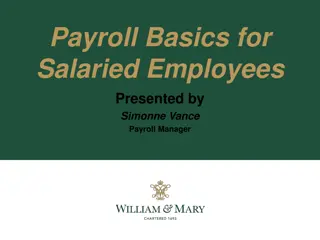
Uncovering the Threat of Viruses in Today's Digital Landscape
Explore the alarming prevalence of computer viruses, the ease of virus creation, and the potential risks they pose. Discover how a comprehensive test was conducted to evaluate user protection levels, using Java for implementation and Selenium for crawling. The results reveal interesting insights and trends on virus exposure.
Download Presentation

Please find below an Image/Link to download the presentation.
The content on the website is provided AS IS for your information and personal use only. It may not be sold, licensed, or shared on other websites without obtaining consent from the author. If you encounter any issues during the download, it is possible that the publisher has removed the file from their server.
You are allowed to download the files provided on this website for personal or commercial use, subject to the condition that they are used lawfully. All files are the property of their respective owners.
The content on the website is provided AS IS for your information and personal use only. It may not be sold, licensed, or shared on other websites without obtaining consent from the author.
E N D
Presentation Transcript
Virus Attack Final Presentation Alex Whiteside | Audrey Simonne
The Threat Of Viruses Over 32% of the world s computer are currently infected with a virus The United States ranks 11th on scale with over 30% infection Viruses cause over $50,000,000,000 (50 Billion) in damage yearly Anyone can create (or buy) a virus off the market and deploy it No Special Skills are required Over 74,000 Strains are created daily by computer polymorphism or by hand Viruses propagate in an exponential way, causing harm as soon as they are detected
Our Test We wanted to determine how protected the average user was from simple web use Two common operating systems : Windows 10, Windows 7 Some form of internal protection, but only the default User running with Administrative privileges People are random, so we wanted random sites For each page we visit, we want to gather all possible links Then open up 5 at random and repeat the process for each new link
The Implementation Language: Java Java was a natural choice due to our programming backgrounds, it s ease of deployment across platforms, and integration with Selenium. Crawler Library: Selenium Selenium is a popular library supporting all OS and web browsers Logging: Custom It was easier to implement our own logging to a file than to configure one
Execution We setup the master and slave and began the test with a seed list of 36 sites. We let the system run for 24 hours We retrieved the logs for both systems We ran a full virus scan on both systems Master (center), Development Computer (left) and Slave (right) running the application and opening web pages.
Results Over 5000 Pages 183 recognized domains Interesting correlation to Hihanin.com Only 2 file downloads No EXEs 0 Viruses on either system
Problems Various Exceptions Random Events Unrecognizable Domains ????????????.?? Malformed Popups Windows Update Many hits to normal sites
Conclusions Simply browsing the web does not present an easy entry point for viruses when using default security. This is important to Domain Administrators, as not all sites need to be blocked if the user does not actively look for downloads. Hihanin.com is very interesting, as many unrelated sites recursively ended up there by random link choices. Numerous exceptions can be thrown for many web related issues, and catching them at every point is the only way to continue operations gracefully.
Next Steps Other entry points for viruses exist, each could be tested in a similar way Email spam, opening and clicking through various ads Torrenting files and running their contents Downloading free software Some users turn off their firewall and deviate from the basic security Use computers that have not just been freshly installed, without patches The tests could be run for longer periods of time










